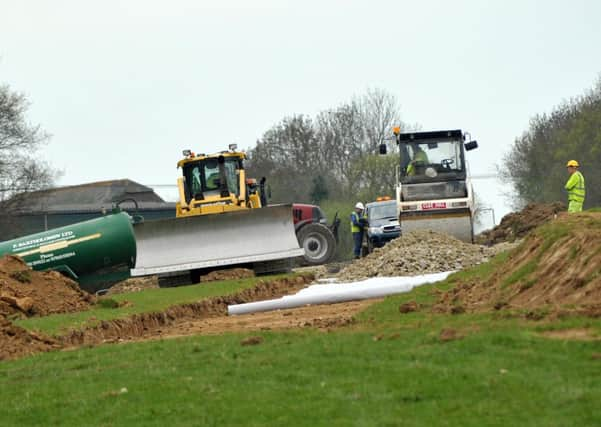Plea to halt link road after new historical finds


Martin White was carrying out his own research into the site at Upper Wilting, Crowhurst, when he discovered an academic paper online, regarding late Saxon era fortifications in the area.
Mr White said: “I found references for, and explanations of, two Saxon documents.
Advertisement
Hide AdAdvertisement
Hide Ad“These respected Saxon documents are lists of forts and their measurements.
“And with minimal further investigation, I find those measurements tally very well with the fortifications at Upper Wilting.
Mr White said he believes archaeologists didn’t fully explore the site before work started on the Link Road.
He said: “The Upper Wilting site could easily have been compared with these Saxon documents, particularly the measurements given in these documents.
Advertisement
Hide AdAdvertisement
Hide Ad“But apparently, nobody even bothered to do this. Not one person in this apparently professional team of archaeologists.
“And because they did not even bother to look, a significant historical site is probably going to be completely demolished without any proper investigation.
“This is just scandalous.”
He added: “I wonder if they spent so much time trying to defend against the suggestions these fortifications were possibly related to the 1066 landings that they actually ended up missing the real story.”
Crowhurst resident Nick Austin, author of the Secrets of the Norman Invasion, has written to Hastings MP Amber Rudd, urging her to intervene and stop the destruction of a potential Burghal Fort.
Advertisement
Hide AdAdvertisement
Hide AdMeanwhile Mr Austin, who previously claimed the Battle of Hastings was fought in the Valley, says he has uncovered evidence that Upper Wilting was the landing site for Julius Caesar in 55BC.
He says the answer lies in a little read book by R C Hussy written in 1858 entitled Archaeologia Cantiana.
Mr Austin said: “Hussy was right to name Bulverhythe as the landing site but he got the detail wrong because he did not know what we know now.
“The peninsular fort was at Upper Wilting Farm as the topography exactly fits where the Saxons later built their Burghal Fort under the instructions of Alfred the Great.
Advertisement
Hide AdAdvertisement
Hide Ad“The evidence to confirm this is in the Roman Shore Fort and network of tracks connecting all the places where the Romans were known to be mining iron at that time.
“I identified it in my evidence to the public inquiry in 1997 but did not know the significance.
“It was not investigated at the time and the county archaeologist did not come down despite repeated requests because he was employed by the people who wanted to build the road through the site and the situation then is the same now. They simply did not want to find something that would cause them a problem.
“None the less the evidence is still there and now we have a threefold national heritage disaster in the making.”
Advertisement
Hide AdAdvertisement
Hide AdCasper Johnson, East Sussex county archaeologist said: “The area of Hastings and Bexhill is certainly of considerable historical and archaeological importance, determined to a great extent by its coastal location, varied topography, rich resources and proximity to the continent.
“While I have seen no hard evidence to support claims that land at Upper Wilting Farm was the site of Caesar’s landing place, the Saxon ‘burh’ of Hastings or Duke William’s camp in 1066, I am certain that the programme of archaeological work being carried out for the Link Road presents an exciting opportunity to develop a much clearer picture of the complex history and archaeology of this area, from the end of the last ice age through to the present day.
“We will be able to chart more clearly the lives of local people from hunter gatherers to the first farmers, iron workers and settlers and how they adapted to and changed the landscape around them.
“One of the planning conditions for the Link Road requires a detailed programme of archaeological work to be carried out. This work is being undertaken by Oxford Archaeology to make sure any areas of potential archaeological interest along the Link Road are investigated, recorded and the findings are shared with the public.
“Significant archaeological finds will either be preserved in situ or, where this is not possible, archaeologically excavated and recorded.”